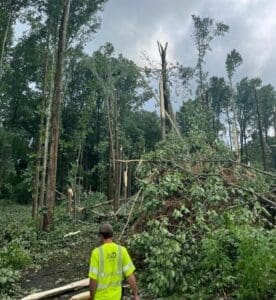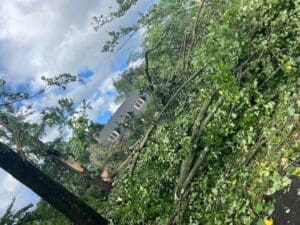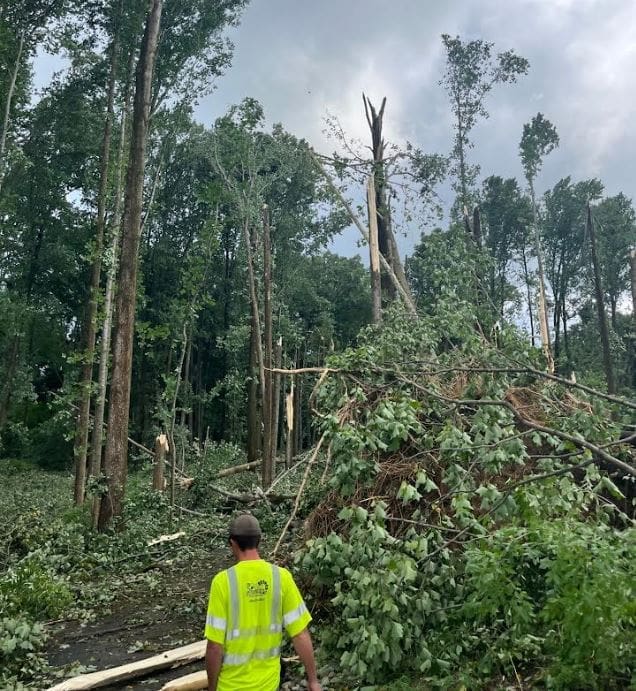
A lot of birch and ash trees just snapped in half because of winds during an Aug. 7 northern New Castle County storm. Photos courtesy Strobert Tree Service Inc.
The trees that seemed to take the brunt of the Aug. 7 storm through northern New Castle County were poplars and ashes, an arborist says.
“They’re just more brittle,” said Tony Marsalo, arborist with Strobert Tree Service Inc.
Their root systems aren’t as deep, but it wasn’t the roots that got them.
“These trees were just snapped in half,” he said. “They have very little flex in them, so they just snap.”
Another big problem was trees with a forked trunk. Many of those just split in half, he said.
Marsalo has been working steadily in Hockessin and other areas helping to clean up storm damage.
He has a specific recommendation for anyone who is out evaluating their own property or trying to clean it up themselves: Look up.
“You have to look up because what’s down on the ground is not going to kill you,” he said. “What’s barely hanging on by a strand of wood above you will kill you.”
He also recommends that people put on a helmet — any kind of helmet, even a son’s or daughter’s hockey helmet — when walking their property after a storm.
“Put it on and be looking up, not down, to assess the damage,” he said.
Even that’s not a perfect safety solution.
His crews have had trees that did not appear to be damaged by this storm topple over as they work on a nearby tree.

Strobert certified arborist Tony Masalo believes homeowners should have the trees on their property surveyed each year to try to avoid problems. Photo courtesy of Strobert Tree Service.
Marsalo, a certified arborist, hopes that one thing people take away from the experience of seeing so much damage is that they should maintain their trees just like they maintain the house by servicing their heating and air conditioning systems or having pest control come annually.
“We have different things checked every year in our house and probably the most important thing is that 100,000-pound tree about 10 feet from your house,” he said.
He has one client who lost 100 trees on their wooded lot.
Some of that, he says, was because the trees were so close together that storm winds couldn’t blow through the trees. Instead, he said, they hit the dense canopy, which acts like a sail and catches the wind, shoving the trees over.
“When there’s pockets and air is able to flow through, the tree is able to keep good structural integrity during a storm,” Marsalo said.
About five families he’s working with had trees fall on or through their houses and now, just as school is starting, they are having to find other places to live while repairs are made.
Tree survey
Homeowners should consider having a certified arborist survey their property once a year and make recommendations about tree health and safety. Strobert will do that for free, he said.
An arborist may recommend something simply like routine pruning or deep tree fertilization, he said.
While a homeowner can easily fertilize grass and plantings, it’s not easy to fertilize a tree, because the nutrients have to be delivered deeply or surface plants will soak them up before they can reach the tree.
Fertilizing a tree enhances regrowth and helps the roots be more vigorous, making the tree stronger and more able to withstand a storm, he said.
Marsalo said he’s not advocating that people don’t have trees near their homes. He loves trees, he said. Mankind and the planet both get a lot of benefits from them such as saving energy and pumping oxygen into the environment.
“But if you’re gonna plant any tree close enough to your house that could change your life forever during a storm, you better make sure you’re having it professionally maintained and on a plant healthcare program,” he said.
DELAWARE EDUCATION: 17 schools show less than 10% proficiency on tests
That’s particularly important as the weather seems to be changing, he said.
Marsalo has lived his life in Philadelphia and Chester County.
No matter the cause, he said, it’s clear that the Delaware region is having more damaging storms than it did 20 years ago and nearly every client mentions something about that to him.
He even sees trouble in the kind of insects and tree diseases now seen in Delaware that once were only seen further south.
One of the most obvious ones, he said, is a fungus attacking the blue spruce. It causes a condition known as needle drop, a nickname for Rhizosphaera Needle Cast.
“If you drive around you’ll see every blue spruce has died,” he said. “They can’t survive this far south.”

Betsy Price is a Wilmington freelance writer who has 40 years of experience, including 15 at The News Journal in Delaware.
Share this Post




